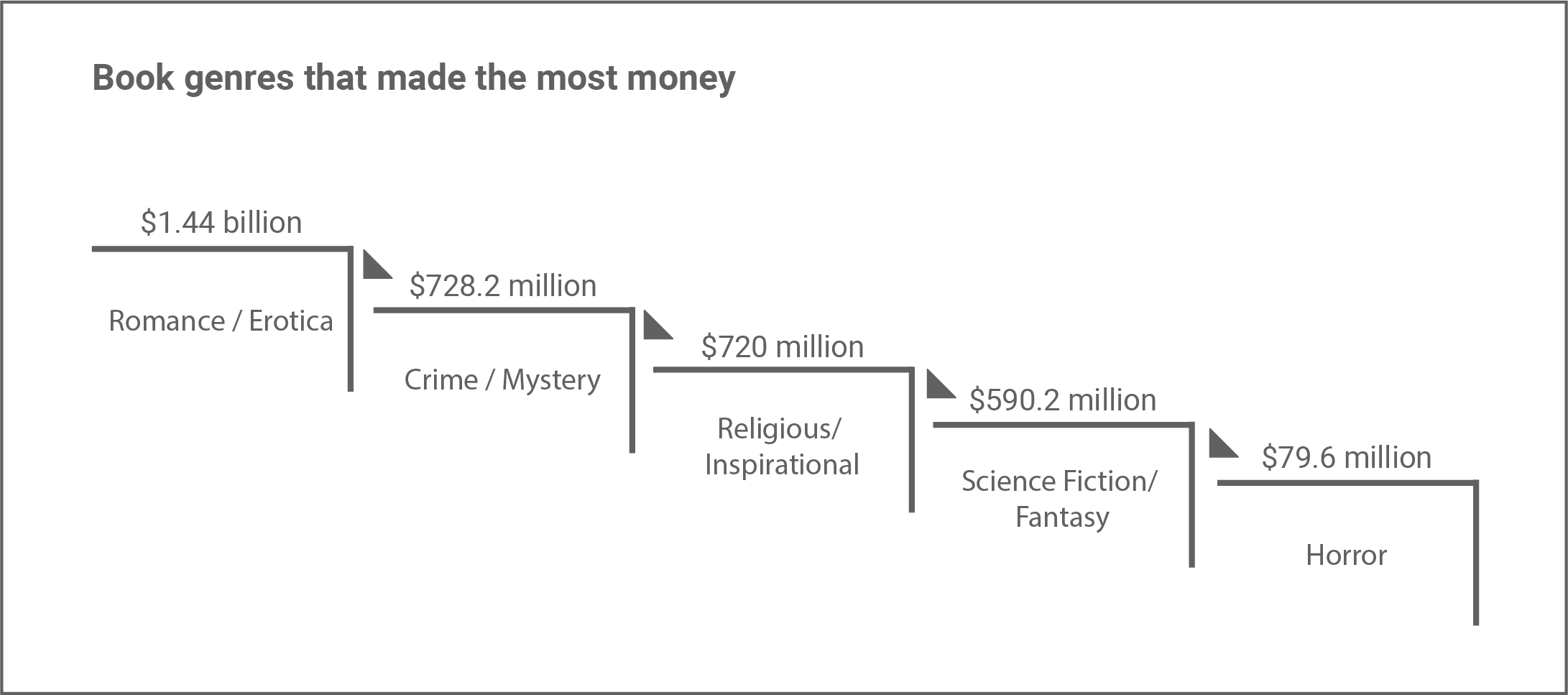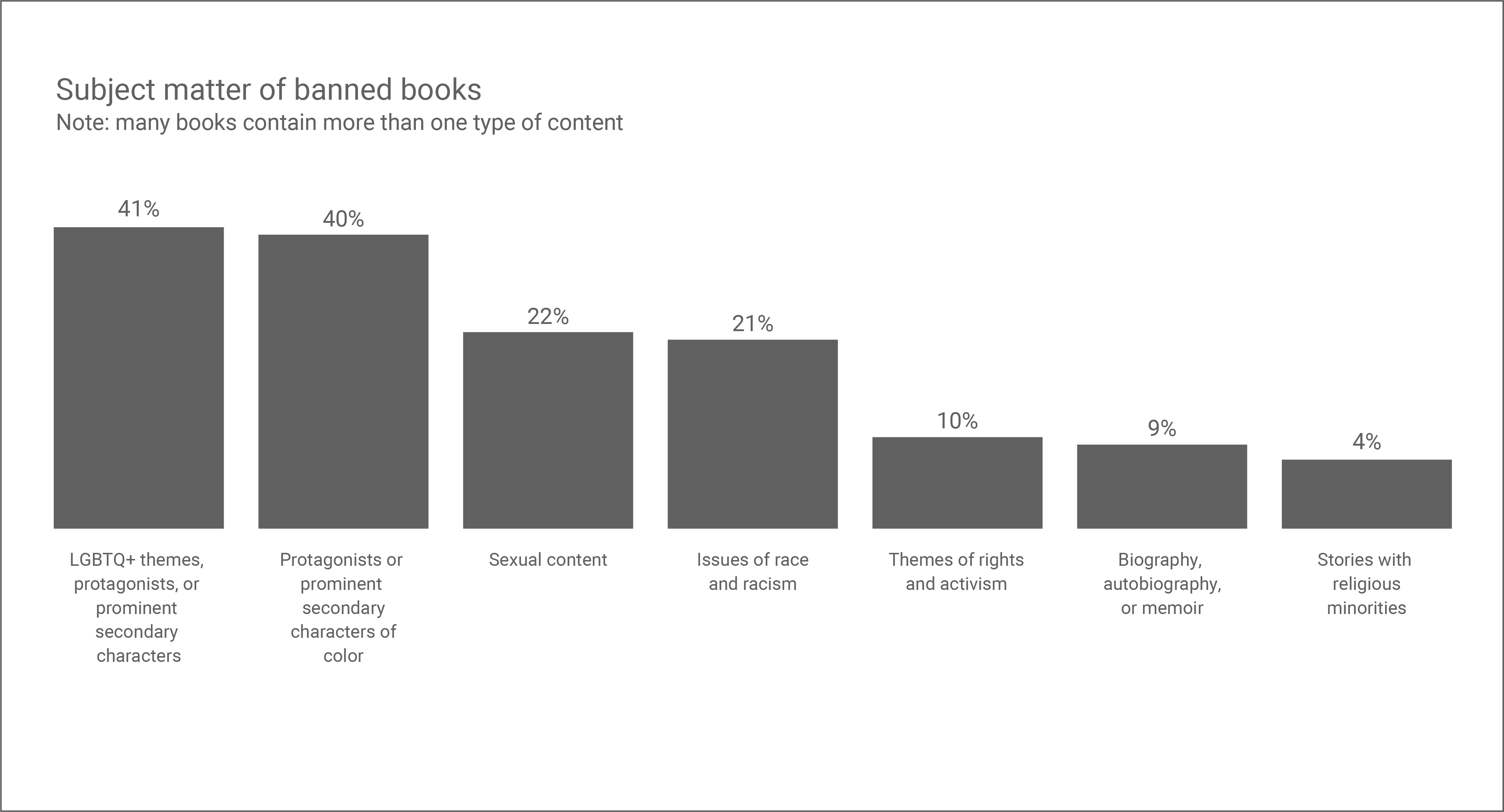Thema 3: Literature at School
Prüfling A
Your school is planning to purchase a number of literary works for teachers and students to choose from on Year 11 and Year 12 English. Students have been invited to have their say. Comment on the chart.Book genres that made the most money in the United States (2022)

Adapted from: https://selfpublishingadvice.org/wp-content/uploads/2022/01/Screenshot-2022-01-04-at-09.53.01.jpg
[accessed: 22 March 2023]
[accessed: 22 March 2023]
Prüfling B
Your school is planning to purchase a number of literary works for teachers and students to choose from on Year 11 and Year 12 English. Students have been invited to have their say. Comment on the chart.Book banning in schools in the US (2021-22)

Adapted from: https://pen.org/wp-content/uploads/2022/09/Subject-Matter-of-Banned-Content.png
[accessed: 22 March 2023]
[accessed: 22 March 2023]
Weiter lernen mit SchulLV-PLUS!
monatlich kündbarSchulLV-PLUS-Vorteile im ÜberblickDu hast bereits einen Account?
Note:
Please note that these solutions are only suggestions. There are various possibilities for argumentation.
Please note that these solutions are only suggestions. There are various possibilities for argumentation.
- Here we are then.
- Let's start with...
- On the one hand / on the other hand
- It must be considered
- In my opinion / I think, personally, ...
- I agree / I disagree
Possible introductions to the topic and the argumentations
Prüfling A
- The chart indicates the revenue generated by different book genres in the United States for the year 2022.
- The genres are listed in descending order of revenue:
- Romance/Erotica: $ 1.44 billion
- Crime/Mystery: $ 728.2 million
- Religious/Inspirational: $ 720 million
- Science Fiction/Fantasy: $ 590.2 million
- Horror: $ 79.6 million
- This data shows that Romance/Erotica is by far the most lucrative genre, earning significantly more than the other genres.
- Crime/Mystery and Religious/Inspirational genres follow, with nearly equal revenues.
- Science Fiction/Fantasy also generates substantial revenue, while Horror earns the least.
Comment on the chart
Prüfling B
- The chart illustrates the reasons behind book bans in US schools during the 2021-22 period.
- The percentages represent the proportion of banned books that contained certain types of content:
- LGBTQ+ themes, protagonists, or prominent secondary characters: 41%
- Protagonists or prominent secondary characters of color: 40%
- Sexual content: 22%
- Issues of race and racism: 21%
- Themes of rights and activism: 10%
- Biography, autobiography, or memoir: 9%
- Stories with religious minorities: 4%
- This data reveals that books with LGBTQ+ themes and protagonists or prominent secondary characters of color are the most frequently banned, each accounting for about 40% of the bans.
- Sexual content, issues of race and racism, and themes of rights and activism are also significant factors for bans.
- Less commonly banned are biographies, autobiographies, memoirs, and stories featuring religious minorities.
Comment on the chart
Argumente für beide Prüfungsteilnehmer
- When choosing literary works for Years 11 and 12, it’s essential to balance educational value, student interest, and social relevance. Educational Value
- Curriculum Alignment: The books should align with the curriculum goals and enhance students' understanding of the themes and concepts being taught.
- Literary Quality: Choose works recognized for their literary merit, including classic literature and award-winning contemporary works. Student Interest
- Genre Popularity: Considering the revenue data, include popular genres such as Romance, Crime/Mystery, and Science Fiction/Fantasy to engage students.
- Diverse Voices: Include works by diverse authors and featuring diverse characters to reflect students' experiences and broaden their perspectives. Social Relevance
- Contemporary Issues: Select books that address current social issues such as race, gender, and equality to foster critical thinking and discussions.
- Banned Books Awareness: While considering the content of banned books, ensure the inclusion of books that challenge students intellectually and ethically, but also be mindful of the community and parental concerns. Inclusivity
- Representation: Ensure representation of various cultures, identities, and perspectives to promote inclusivity and empathy among students.
- Sensitivity: Be cautious with sensitive content, providing appropriate context and support for students when necessary.
- By applying these criteria, the selection process will help provide a diverse, engaging, and educational range of literary works for students in Years 11 and 12.
Selection Criteria for English-Language Literary Works for Year 11 and 12